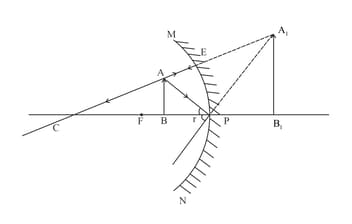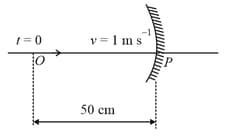What do you mean by spherical mirror formula?
Important Questions on Reflection of Light
An object is placed beyond the centre of curvature of the given concave mirror. If the distance of the object is from and the distance of the image formed is from the radius of curvature of this mirror is:
An object is placed at distance infront of a concave mirror of radius of curvature . Find the position, nature and magnification of the image.

Deduce the mirror formula
( where the symbols have their usual meanings ) for a concave mirror forming real image.
An object is placed at a distance of from a convex lens. A convex mirror of focal length is placed on another side of the lens at as shown in the figure. The image of the object coincides with the object.

When the convex mirror is removed, a real and inverted image is formed at a position. The distance of the image from the object will be
A ray of light parallel to the principal axis of a spherical mirror falls at a point as shown in the figure below:

By drawing a suitable ray diagram, obtain the mirror equation.
A point object is moving uniformly towards the pole of a concave mirror of focal length along its axis as shown below. The speed of the object is . At , the distance of the object from the mirror is . The average velocity of the image formed by the mirror between time and is:

| Object pin | Convex Lens | Convex Mirror | Image Pin |
| 22.2 cm | 32.2 cm | 45.8 cm | 71.2 cm |

